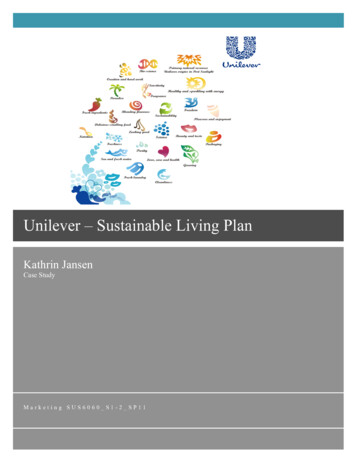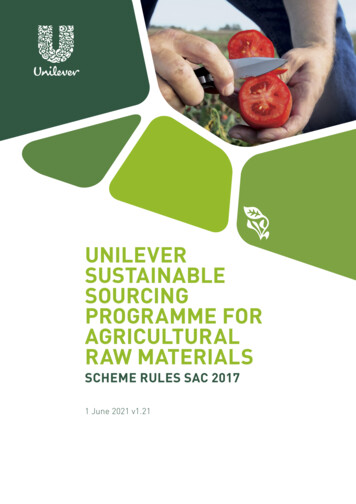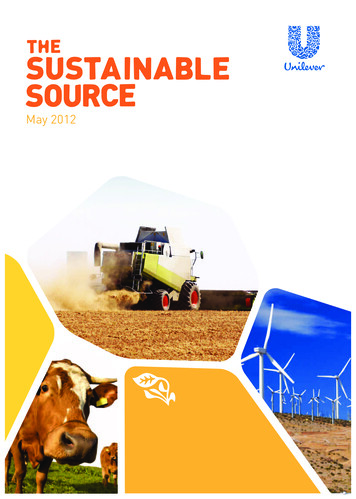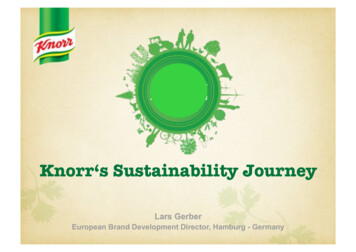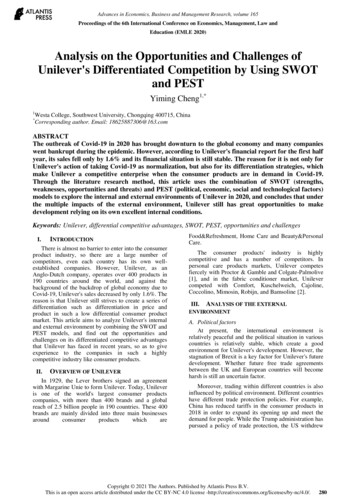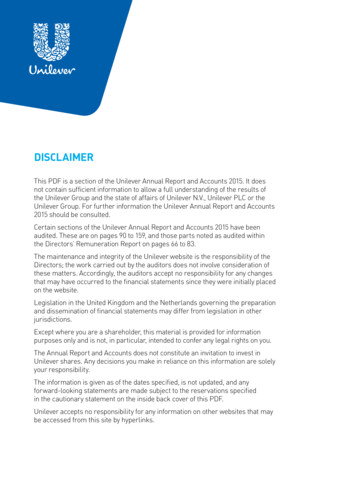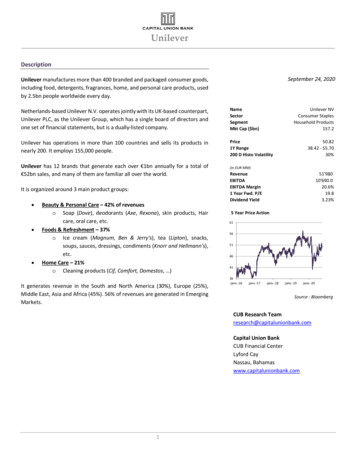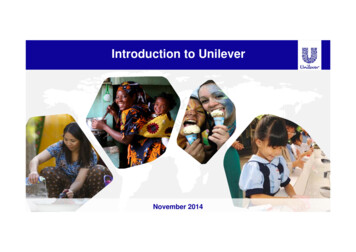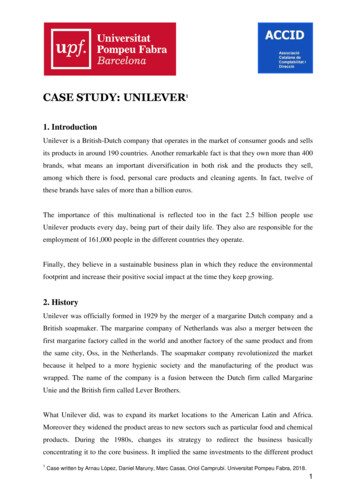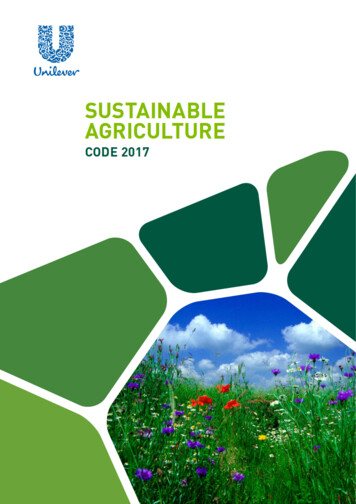
Transcription
INTRODUCING THE 2017 REVISION OF THEUNILEVER SUSTAINABLE AGRICULTURE CODEThe Unilever Sustainable Agriculture Code is one of the major tools in our sustainable sourcingprogramme. Since 2010, when it was first launched, it has helped us gain a clear overview of howquickly we are progressing towards our sustainability ambitions in agricultural sourcing. This year, weare launching a new updated version of the Code to reflect our evolving understanding of sustainabilityand of the contexts – geographical, cultural and political – within which our farms operate. As with theoriginal version, our new Code sets out major targets for farms and suppliers to work towards, inspiringthem to make sustainability mainstream. It is also closely aligned with other Unilever policies, such asUnilever’s land rights policy.WHAT IS THE PURPOSE OF THE UNILEVERSUSTAINABLE AGRICULTURE CODE?The Code can be used in different ways. For example,The Unilever Sustainable Agriculture Code is a collec it provides a consistent set of criteria for assessingtion of Good Practices which aim to codify importanthow suppliers, and the farmers who supply them, areaspects of sustainability in farming and to apply them toprogressing when it comes to sustainability. It can also beour Supply Chain. The scope and ambition of the Codeused to benchmark externals standards and to make deci reflect the Unilever Sustainable Living Plan objectives,sions upon sustainable sourcing. But first and foremost, itmaking it fundamental to our business. In tandem withis used as the standard that Unilever aims to achieve.HOW DO WE USE THE CODE?positive partnerships along our supply chain, the Code willdrive sustainable development and responsible sourcingpractices.WHAT IS THE ETHOS OF THE CODE?The Code represents a holistic approach to sustainableagriculture. It is wide-ranging in scope, applying to diversePRINCIPLES OF SUSTAINABLE AGRICULTUREgeographies and farming systems (from smallholders toUnilever adheres to the following principles of sustainablelarge plantations). It also acknowledges diverse politicalagriculture since the year 2000:contexts, covering nation-states with strong legal frame -Produce crops with high yield and nutritional quality toworks, commitments to sustainability and subsidies – andmeet existing and future needs, while keeping resourcenation-states who have not developed these structures toinputs as low as possible.the same extent.Ensure that any adverse effects on soil fertility, waterImplementation challenges vary enormously. In the devel and air quality, and biodiversity from agricultural activi oped world, farmers already see themselves as under ties are minimised, and positive contributions are madevalued for their hard work and overburdened by regulationwhere possible.and administrative tasks. So they are not always easilyOptimise the use of renewable resources while mini amenable to implementing frameworks which go beyondmising the use of non-renewable resources.existing legal requirements.Enable local communities to protect and improve theirElsewhere, the problems are different. Smallholders, inwellbeing and environmentparticular, may have neither the training, resources nor--These principles represent the right combination ofpower to develop the productive and resilient food produc economic development, environmental protection andtion systems required to feed a growing world population,social improvement. We look for these principles to benor to provide a living income for their families.reflected in all sustainability standards we work with.4Sustainable Agriculture Code 2017
1 AGRICULTURE - CROP AND PASTURE NUTRIENT(FERTILISATION) MANAGEMENT1.1 Integrated nutrient managementF1Nutrient Management Plan andnutrient application recordsThere shall be a Nutrient Management Plan implemented on everyfarm. The plan shall be prepared and/or designed by a competentindividual or authority, who may be part of the supplier agronomyteam. The Nutrient Management Plan will include a requirement tokeep records of nutrients applied for at least 2 years.ExpectedF2Taking crop needs into accountThe nutrient requirements of the crop or pasture must be under stood at all stages of growth, and used to design the NutrientManagement Plan.ExpectedF3Informed by nutrient deficiencysymptoms, soil and tissue analysesRegular soil and/or tissue nutrient testing shall be used to adjust theapplication rates, as part of the Nutrient Management Plan. If this isnot practical, the observation of nutrient deficiency/over applicationsymptoms on the crop or pasture may be used as an indicator.ExpectedF4Soil and weather conditionsSoil conditions shall be used to adjust the application rates, as partof the Nutrient Management Plan. If different parts of the farm havedifferent soils, nutrient management is expected to vary appropri ately. Nutrient applications must be timed to avoid application duringperiods of heavy rain, snow or frozen ground, cracked, waterloggedor compacted soils, as nutrients will not be retained in the soil undersuch conditions.ExpectedF5Inputs - nutrient contents and asso ciated risksThe nutrient content and availability of fertilisers, manures,composts, cover crops and crop residues used shall be recorded,tested and/or estimated, and the results used to inform the NutrientManagement Plan.ExpectedF6Nitrogen and phosphoruscalculationsThe Nutrient Management Plan must include a calculation of theamount of Nitrogen and Phosphorus to be applied in each year,taking into account all sources of nutrients applied and those avail able from the soil. The calculation must also include an assessmentof the amount of nutrients removed from the crop or pasture byharvesting and/or grazing.ExpectedF7Minimise risks of contamination andpollution associated with nutrientinputsNutrient sources that can pose risks to people, the environmentor product quality shall be avoided. This can be achieved either bytesting inputs for contaminants to ensure that levels are below toler able limits OR by an assurance/investigation that shows the sourceof the material to be free from contamination.Expected1.2 Application of fertilisers, manures, composts and other plant nutrient8F8Application equipment - maintenanceand cleaningApplication equipment must be maintained in good working orderand safe to use. It is cleaned after use.ExpectedF9Application equipment - calibrationApplication equipment (including fertigation) must deliver thedesired flow rates and distribution patterns. Manual application offertilisers shall achieve even distribution and correct placement ofthe fertiliser.ExpectedF10Application methods adopted thatminimise waste and pollutionHigh trajectory application techniques for spreading slurry and othernutrients are wasteful and also increase the risk of exposing water,living areas, public areas, or areas of high biodiversity value (whichusually require low rates of nutrient inputs). High-risk techniquesmust be abandoned or modified by using technologies such asdeflector plates, incorporation /injection of slurry or urea-basedfertilisers, spot or hand application.ExpectedSustainable Agriculture Code 2017
4 WATER MANAGEMENT(RESOURCE AND ENVIRONMENTAL MANAGEMENT)Some aspects of water management are covered by Unilever’s Responsible Sourcing Policy for farms.4.1 Improving water use and water use efficiency (excluding irrigation)F36Drain managementDrains must be constructed in such a way that soil erosion isminimised during drainage (e.g. running across slopes, lining withvegetation or hard surfaces). Drains must discharge into riparianareas rather than directly into surface waters, or diffuse discharge/protected discharge must be arranged.ExpectedF37Water infrastructureEnsure water infrastructure is in good working condition byinspecting taps, water supply pipes, water troughs, drainage chan nels and receiving waterways regularly, and ensure rapid repairswhen leaks are found. Where necessary protect pipes from frostdamage.ExpectedF38Reduction in water use, includingre-use of water (excluding irrigation)Water use in washing-down animal housing and yard areas shouldbe reduced by scraping or sweeping floors before washing down,using high-pressure hoses, or re-using wash down water from foodpreparation areas.LeadingF39Water retentionIn areas where high wind speeds are encountered, use windbreaksor cover crops to reduce water (and soil) loss. Wind breaks shouldalso be used to protect livestock from extreme weather.LeadingF40Sustainable withdrawal (abstraction)of waterTick which applies (F40a - F40c).F40a. No water withdrawal. Note - if you irrigate or are involved inanimal husbandry, this option is not available to you.*N/AF40b. Legal Compliance. If it is necessary to have a licence orpermit to extract the volume of water you use, the licence must havebeen obtained, and the volume of water stated on the licence mustnot have been exceededMandatoryF40c. If no licence or permit is required, there must be evidencethat current rates of abstraction are acceptable to relevant author ities (e.g. in the form of metered delivery and payments through anational distribution scheme, or there has been advice from waterauthorities or a relevant consultant that current rates of abstractionare acceptable).ExpectedF41Equable distribution within thecatchmentWater harvesting and withdrawal are monitored, and systems are inplace to try, as far as practicable, to meet the needs of local commu nities, other water users, as well as wildlife and ecosystems in thecatchment. If there are Land Care or Catchment Management Plansavailable, these should be complied with.LeadingF42No use of water bodies as wastedumpsNeither you nor your workers ever dispose of inappropriate mate rials (such as oil, CPPs, CPP packing or containers, medicines,animal manure) in rivers, streams or other surface or ground water.MandatoryF43Protecting water bodies from pollu tion by sewage and wash waterSurface and ground water must be protected from direct and indirectpollution. Toilets, water used for cleaning milking parlours, andlivestock yard washing-water must not discharge directly into water courses but discharged at a sufficient distance to avoid any infiltra tion through soil into watercourses and water tables. If it is neces sary for livestock to cross watercourses, the crossing points must bemade of hard materials to minimise riverbank erosion into the water.Machinery must not be washed directly in streams or rivers.ExpectedF44Protecting water bodies from pollu tion by agricultural activitiesLosses of nutrients, CPPs and agricultural soil to water must beminimised, as must the over application of nutrients on land adja cent to, or draining into, watercourses.ExpectedF45Buffer zonesBuffer zones adjacent to streams, rivers, wetlands, ponds and otherwater bodies are planted, maintained or restored, preferably withnative species. Please tick whichever applies, F45a or 45b.12Sustainable Agriculture Code 2017*
5 BIODIVERSITY AND ECOSYSTEM SERVICESAspects of land use change, involving FPIC, are covered in Unilever’s Responsible Sourcing Policy for farms and Land Rights Policy.5.1 Land Conversion - biodiversity and ecosystem servicesF55No conversion of High ConservationValue Areas (cut-off date whenSAC2017 implemented)The conversion of High Conservation Value/High Ecological Value/high carbon stock areas (forests, grasslands or wetlands) to farm land is prohibited.F56No deforestation (cut-off date whenSAC2017 implemented)Unilever wishes to achieve “zero-net-deforestation” for our agricul tural supply chains. Ideally, no land shall be converted from forestto agricultural land on farms that supply Unilever. If some foresthas to be destroyed, for example for road building, the loss shall becompensated for.F57No hunting, fishing or gatheringof rare, threatened or endangeredspeciesThe hunting, fishing or gathering of rare, threatened or endangeredspecies on the farm is prohibited. All farmers and workers shall beinformed that destroying important habitats on-farm (or off-farmbecause of farming activities) is not allowed.S2Grants and government supportWhere there is government support for biodiversity work, suppliersmust ensure that farmers are aware of the support available andfacilitate their access to such support.S3Co-ordination of farmer’s BiodiversityAction PlansSuppliers have a responsibility to ensure that there is documentedevidence that every farm either has an individual Biodiversity ActionPlan (BAP) - OR shall themselves co-ordinate farmers’ activitieswithin a BAP that encompasses a range of activities across thefarmed landscape from where raw materials are purchased.MandatoryS4BAP prioritiesThe BAP shall include a map or other assessment of the farmedlandscape including assessing the presence or absence of (i) rare,threatened or endangered species and habitats, (ii) parts of thelandscape of High Conservation, (iii) parts of the landscape withvalue for biodiversity and (iv) parts of the landscape providing valuedecosystem services. The presence of any known wildlife corridorswithin the landscape shall be included in the documentation/map.ExpectedS5Ensuring action and progressThe BAP must include a list of actions that farmers can take tosupport biodiversity. These must be related to the local biodiversitypriorities, and issues on which farming has direct or indirect influ ence. These can include discussions with NGOs and governmentsor priorities, and awareness-raising and training in the first year,but must thereafter move to pilot scale and actions on every farm.Progress over time must be shown, preferably by setting measurablegoals on monitoring programme towards them.ExpectedF58BAPThe BAP should focus upon at least one of the following themes(A-G). Tick all those that apply for each farm separately. Note: If youhave ticked theme B (Enhancing local high conservation values) orE (General landscape improvements for wildlife), and if your farmoperation is in Western Europe, consider using the Biodiversity toolof Cool Farm Alliance to test the rigor and potential effectiveness ofyour BAP y/).ExpectedF58 - Theme A Conservation of rarespecies or habitatsIf rare, threatened or endangered species or habitats exist locally,then the BAP must include an evaluation of the risks posed to thespecies or habitat, and commitment to maintaining/enhancing thefarmed landscape for their benefit. The BAP includes a monitoringprogramme to determine if the plan is being successful.***F58 - Theme B Enhancing local highconservation valuesIf there are High Conservation Value forests, wetlands or other areaswithin or adjacent to the farmed landscape, on-farm BAP activitiescan be focussed on enhancing these values.***F58 - Theme C Development, main tenance or improvement of wildlifecorridorsCreating, maintaining and enhancing a network of natural vegeta tion (“wildlife corridors”) along live fences, hedges, ditches, riparianstrips, roadside and field margins across the landscape.***14Sustainable Agriculture Code 2017MandatoryExpectedMandatoryExpected
8 SOCIALAdditional social aspects are covered in Unilever’s Responsible Sourcing Policy for farms.8.1 Health and safetyF77Potable water and hygiene provisionWorkers will have free access to potable water, hand-washing facili ties and shelter for breaks and mealtimes. Farm workers in remoteor temporary locations must be able to bring potable water, washingwater and soap (in order to wash hands before eating) to work, orthe farm must provide these (e.g. when bringing food into the field,or collecting harvested material). Workers in or near buildingsmust have access to clean toilets, hand washing with soap, and foodstorage facilities.F78First AidAll workers must have access to First Aid and medical servicesduring working hours sufficient to respond to emergencies.ExpectedF79Healthy lifestylesFarms will promote a healthy lifestyle, and raise awareness of widerissues of health and safety (e.g. HIV/aids). These may extend into thewider community.LeadingF80Health adviceWorkers who do hazardous work (e.g. handling pesticides, handlinganimals, driving) or perform strenuous physical activity (such asregularly carrying heavy loads) must be offered risk-based healthchecks.ExpectedF81Time off for medical careWorkers must have the right to time off work, for medical appoint ments and counselling for themselves and their dependants.ExpectedF82Hazard reduction: WHO1a CPPsActive ingredients classified as WHO 1a, or listed in MontrealProtocol (this includes methyl bromide) or the Stockholm Conventionon Persistent Organic Pollutants are NEVER used on the farm.Exceptions are for extremely small volumes used in pheromonetraps, rat baits and insecticides used in animal husbandry (in partsof the world where there is no effective alternative).MandatoryF83Hazard reduction: WHO1b CPPsActive ingredients classified as WHO1b or the Basel or RotterdamConventions shall be phased out of use within 3 years, after date ofimplementation. In each of the 3 years, there must be documentedevidence of research into alternatives, a phase out plan or actualreduction in use.MandatoryF84Hazard reduction: Choice of CPPWhere there is a choice of which CPP to use, the hazards to humanhealth (e.g. the option with the least hazardous WHO or EPA rating)and the local environment must be taken into account unless aprogramme of active ingredient rotation is in place in order to reducethe risk of resistance developing.ExpectedF85CPP exposure reduction: protectingthe most vulnerableYoung people (under 18 years old), pregnant and nursing mothersshall NEVER handle or apply CPPs as part of their job or be exposedto CPP contaminated PPE.MandatoryF86CPP exposure reduction: trainedoperatorsOperators shall only handle or apply CPPs if they have received basictraining in how to protect themselves, their family, bystanders, thelocal community and the environment from harm. All operators mustbe provided with appropriate PPE, free of charge.MandatoryF87CPP exposure reduction: no reuse ofcontainersReusing CPP containers for any purpose (other than professionalre-filling of proprietary containers) is prohibited. This obviouslyincludes re-use for human or animal food or water.MandatoryF88CPP exposure reduction: avoidingpollution (spills and equipmentcleaning)Procedures are in place to minimise the likelihood of spillage ofCPPs, to confine spills and contaminated wash-water to areas wherethey will be confined or dispersed safely, and to clean up spills if theyoccur.ExpectedF89CPP exposure reduction: equipmentstorage and handlingCPP application equipment and measuring/weighing equipmentmust be stored and handled as specified by the CPP manufacturers.Equipment must be kept in a secure location separated from livingquarters, food or feed.Expected18Sustainable Agriculture Code 2017Mandatory
8.2 Building positive relationshipsF103Worker suggestionsFarms must have mechanisms in place to take up ideas andsuggestions from the workers and provide regular opportunities fortwo-way dialogue. Farms or plantations employing a large workforceare expected to have women’s committees, that work with manage ment, to resolve gender or other group-specific issues.ExpectedF104MulticulturalismWhere the workforce is of mixed ethnicity/religion/origin, efforts/opportunities are made to ensure that different groups mix in anenvironment that promotes harmony in diversity. This includesdiscussions and briefing between local communities and migrantlabour to support mutual understanding, avoid giving offense andpromote good relationships.LeadingF105RemissionsFarmers should provide support for workers who wish to remitmoney to their family (e.g. time off during banking hours, access totranslators).LeadingS11Co-ordination of farmer meetingsSuppliers must ensure that there are regular meetings for farmersand/or farmer groups to discuss not only quality, price and deliverydates, but also to promote more sustainable farming practices andunderstand how any problems the farmers are facing might beovercome.MandatoryF106Local initiativesLarge farms and plantations should support local farming initia tives, festivals and competitions and/or social or environmentalprogrammes.LeadingS12Local farming initiativesSuppliers should support local farming initiatives, festivals andcompetitions and/or social or environmental programmes.LeadingF107Informing community of plannedactivitiesNeighbours and local communities must be informed of plannedactivities that affect them in a timely manner. This means that theright people to tell, and effective communications channels to thelocal community, are identified in advance. Disturbance of localcommunities must be minimised.ExpectedF108Community complaintsComplaints from the local community should be documented andattempts made to avoid similar problems in the future. The outcomeshould be communicated back to the person or organisation thatcomplained. During land acquisition, devise a culturally appropriateand accessible system that allows community members to filecomplaints about the process. Ensure the community members areaware of that system, track the complaints, and respond to suchcomplaints within a specified time period.LeadingF109Relationships with suppliers andpurchasersPay and supply on time and at the mutually agreed price.ExpectedS13Relationships with suppliers andpurchasersPay and supply on time and at the mutually agreed price.ExpectedS14Avoiding wasted productionSuppliers must inform farmers as soon as possible if their produceis not required for processing, so they can make other arrangementsfor using the land, labour or product, if at all possible.Expected8.3 Service provision to workers and communities (large farms and plantations)F110Provision of services and facilitiesAll provisions of services and facilities for workers and their depend ents shall be at, or above, the legally required minimum standardand must meet the basic needs of workers and their families.MandatoryMandatory8.4 Land rights and obligationsF111Legal or customary right to farm thelandThe farmer must have the legal or customary right to farm the landin the form of ownership, tenancy or traditional rights, and conform ance to government or local authority zoning schemes that enablethe land to be farmed.F112Clarity on rights on other lands userson farmsThere must be clarity of rights of other land users on all farms.Traditional access rights to the farmland - e.g. for cultural , reli gious, or wild harvesting reasons – must be maintained.20Sustainable Agriculture Code 2017Expected
F127Animal welfare KPIsFarmers should develop and monitor animal welfare KPIs appro priate for their farming system and species held, e.g. % mortality,growth rate, lameness, mastitis etc. Monitoring results shouldbe analysed to highlight issues and guide any necessary remedialaction.LeadingF128Health planA documented Health Plan must be developed in consultation witha veterinary surgeon. The plan should include identified diseases,treatment schedules for regularly encountered conditions, vaccina tion protocols, parasite controls, protocols for pre-delivery healthchecks, quarantine procedures, bio-security procedures, and moni toring protocols. The plan should be reviewed on an annual basis.ExpectedF129Hormones and antibioticsHormones and antibiotics must be used prudently with the aim ofoptimising therapeutic efficacy and minimising the development ofantibiotic resistance. Products or equivalent products (e.g. fluoro quinolones) that can be used to treat human disease must not beused unless deemed necessary by a vet.ExpectedF130Record keepingRecords must be kept of the following: animals bought, sold,produced and destroyed (traceability), feed supplements purchased,medicines (including all antibiotics) administered, veterinaryinterventions carried out. Records must be traceable (to the indi vidual, flock or herd as appropriate) and accessible for 2 years afterdisposal of animal.Expected9.2 Live animal transportS15Hauliers and vehiclesSuppliers must ensure that hauliers are approved under an assur ance scheme (if available) and that vehicles used for live animals arefit for purpose.ExpectedS16Training of staffPersonnel employed for loading and unloading animals (includingcatching poultry) must be trained and competent.ExpectedS17Prohibited actionsWhen handling or moving animals it is prohibited to strike or applypressure to sensitive parts (e.g. eyes, nose, tail, genitals), suspend,throw or drag live animals.S18Use of electric goadsElectric goads must only be used on adult animals who refuse tomove with passive methods - not in the first instance.ExpectedS19Fitness to travelAll animals must be fit to travel (i.e. journey must not causesuffering or injury) and there must be an inspection before loading toensure this is the case.ExpectedS20Loading rampsLoading ramp angles must comply with the implementation guide lines for the relevant species.ExpectedS21Food and water provisionThe need for food and water in transit varies depending on length ofjourney, climate etc. Provision must be aligned with local legislationor recommendations. For poultry, the period of feed withdrawalshould not exceed 12 hours (empty feeder to slaughter time).ExpectedS22SegregationCertain groups of animals must be transported separately fromothers. See Implementation Guide.ExpectedS23Stocking densityStocking densities in vehicles must be appropriate to the type ofstock, duration of the journey and climatic conditions. Requirementsfor individual species are detailed in the implementation guide - youmust adhere to these requirements.ExpectedS24Journey timesJourney times must comply with local regulations, and the equip ment on board the vehicle must be suitable for the journey time. Inthe absence of any local legislation, the EU legislation detailed in theimplementation guide must be adhered to.ExpectedS25Emergency planAn emergency plan must be in place to deal with emergencies suchas animals falling ill, delays, breakdowns or accidents.ExpectedS26Transport certificatesAnimals must be accompanied by transport documentation to enabletraceability, monitoring of transport times and stocking densities.ExpectedS27MonitoringSuppliers should encourage the use of outcome measures, e.g. %of animals slipping, % of cattle moved with a goad and % effectivestunning with hauliers and slaughterhouses.Leading22Sustainable Agriculture Code 2017Mandatory
12 UNILEVER’S RESPONSIBLE SOURCING POLICYFOR FARMS12.1 Business is conducted lawfully and with integrityF163Legal Compliance (RSP 1.1)All relevant international and national laws and regulations notcovered elsewhere in this code are complied with.MandatoryF164No Bribery (RSP 1.2)There is a prohibition on any and all forms of bribery.MandatoryF165Financial accounts (RSP 1.6)Large farms must keep financial accounts. Individual smallholdersare not expected to keep accounts.MandatoryF166Product Quality (RSP 1.8)Procedures are in place on farm to ensure that products meetcustomer specifications and quality and safety requirements.MandatoryF167Reporting Concerns andNon-retaliation (RSP 1.9)Employees on large farms and plantations have a channel throughwhich they can raise concerns regarding business integrity (e.g.dishonest or unfair business dealings) without fear of retaliation.Smallholders must have a mechanism for raising concerns withthe processor. Workers for smallholders should have a route ofcomplaint through to any smallholder umbrella organisation inexistence.Mandatory12.2 Protecting the Rights of Workers and CommunitiesF168Work is conducted on the basis offreely agreed and documented termsof employment (RSP 2)All workers, both permanent and casual, are provided with employ ment documents that are freely agreed and which respect their legalrights.MandatoryF169All workers are treated equally andwith respect and dignity (RSP 3.1)No worker should be subject to any physical, sexual, psychological orverbal harassment, abuse or other form of intimidation.MandatoryF170All workers are treated equally andwith respect and dignity (RSP 3.2)Large farms must have employment policies in place to preventdiscrimination based on race, ethnicity, age, role, gender, genderidentity, colour, religion, country of origin, sexual orientation,marital status, pregnancy, dependants, disability, social class, unionmembership or political views. Smallholders must understand thatdiscrimination is not acceptable.MandatoryF171Work is conducted on a voluntarybasis (RSP 4)Under no circumstances will a farm use forced labour, whetherin the form of compulsory or trafficked labour, indentured labour,bonded labour or other forms. Mental and physical coercion, slaveryand human trafficking are prohibited.MandatoryF172All workers are of an appropriate age(RSP 5)Under no circumstances will a farm employ individuals underthe age of 15 or under the local legal minimum age for work ormandatory schooling, whichever is higher. When young workers areemployed they must not do work that is mentally, physically, sociallyor morally dangerous or harmful or interferes with their schoolingby depriving them of the opportunity to attend school.MandatoryF173All workers are paid fair wages(RSP 6)All workers are provided with a total compensation package thatincludes wages, overtime pay, benefits and paid leave which meetsor exceeds the legal minimum standards or appropriate prevailingindustry standards, whichever is higher, and compensation termsestablished by legally binding collective bargaining agreements areimplemented and adhered to.MandatoryF174Working hours for all workers arereasonable (RSP 7)Workers are not required to work more than the regular and over time hours allowed by the law of the country where the workers areemployed. All overtime work by workers is on a voluntary basis.Manda
The Unilever Sustainable Agriculture Code is one of the major tools in our sustainable sourcing programme. Since 2010, when it was irst launched, it has helped us gain a clear overview of ho

